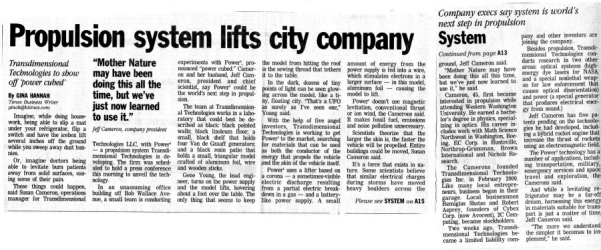Propulsion system lifts city company
Transdimensional Technologies to show off 'power cubed' - by Gina Hannah
Times Business Writer - ginah@htimes.com
(NOTE: before you buy into all this,
check out the DeSeversky file at the bottom of this page)
Imagine, while doing housework, being able to slip a mat under your refrigerator, flip a switch and have the icebox lift several inches off the ground while you sweep away dust bunnies. Or, imagine doctors being able to levitate burn patients away from solid surfaces, easing some of their pain. These things could happen, said Susan Cameron, operations manager for Transdimensional Technologies LLC, with Power cubed, a propulsion system Transdimensional Technologies is developing. The firm was scheduled to hold a press conference this morning to unveil the technology. In an unassuming office building off Bob Wallace Avenue, a small team is conducting experiments with Power Cubed, pronounced 'power cubed'. Cameron and her husband, Jeff Cameron, president and chief scientist, say Power Cubed could be the world's next step in propulsion. The team at Transdimensional Technologies works in a laboratory that could best be described as black; black painted walls; black linoleum floor; a small, black shelf that holds four Van De Graff generators; and a black resin patio that holds a small, triangular model crafted of aluminum foil, wire and wooden sticks. Gene Young, the lead engineer, turns on the power supply and the model lifts, hovering about a foot over the table. The only thing that seems to keep the model from hitting the roof is the sewing thread that tethers it to the table. In the dark, dozens of tiny points of light can be seen glowing across the model, like a tiny, floating city. 'That's a UFO as surely as I've seen one,' Young said. With the help of five angel investors, Transdimensional Technologies is working to get Power Cubed to the market, searching for materials that can be used as both the conductor of the energy that propels the vehicle and the skin of the vehicle itself. Power Cubed uses a lifter based on a corona - a sometimes - visible electric discharge resulting from a partial electric breakdown in a gas - and a battery-like power supply. A small amount of energy from the power supply is fed into a siwer, which stimulates electrons in a larger surface - in this model, aluminum foil - causing the model to lift. Power Cubed doesn't use magnetic levitation, conventional thrust or ion wind, the Camerons said. It makes fossil fuel, emissions and noise pollution unnecessary. Scientists theorize that the larger the skin is, the faster the vehicle will be propelled. Entire buildings that could be moved, Susan Cameron said. It's a force that exists in nature. Some scientists believe that similar electrical charges during storms have moved heavy boulders across the ground, Jeff Cameron said. 'Mother Nature may have been doing this all this time, but we've just now learned to use it,' he said. Cameron, 45, first became interested in propulsion while attending Western Washington University. He earned a bachelor's degree in physics, specializing in optics. His career includes work with Math Science Northwest in Washington, Boeing, EC Corp. in Huntsville, Northrup-Grumman, Brown International and Nichols Research. The Camerons founded Transdimensional Technologies Inc. in February 2000. Like so many local entrepreneurs, business began in their garage. Local businessmen Remigrius Shatas and Robert Asprey, founders of Cyber Corp. (now Avocent), 2C Computing, became stockholders. Two weeks ago, Transdimensional Technologies became a limited liability company and other investors are joining the company. Besides propulsion, Transdimensional Technologies conducts research in two other areas; optical systems (high-energy dye lasers for NASA and a special nonlethal weapon for law enforcement that causes optical disorientation) and power (a special generator that produces energy from sound.) Jeff Cameron has five patents pending on the technologies he had developed, including a hybrid rocket engine that increase the thrust of rockets using an electromagnetic field. The Power Cubed technology has a number of applications, including transportation, military, emergency services and space travel and exploration, the Camerons said. And while a levitating refrigerator may be a far-off dream, harnessing this energy in materials suitable for transport is just a matter of time, Jeff Cameron said. 'The more we understand the simpler it becomes to implement,' he said.

this is the exact same thing which barely lifts itself and won't lift a power supply
they should do their homework, see how easy it is to get money??? Return to KeelyNet